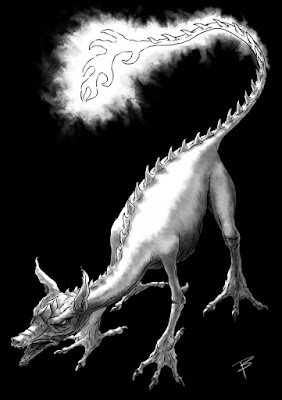IRONBEAK
FREQUENCY: Rare
NO. APPEARING: 1-2
ARMOR CLASS: 4 (tail 6)
MOVE: 18"
HIT DICE: 4
% IN LAIR: 15%
TREASURE TYPE: E
NO. OF ATTACKS: 2
DAMAGE/ATTACK: 1-10, 1-10
SPECIAL ATTACKS: See below
SPECIAL DEFENSES: Nil
MAGIC RESISTANCE: Standard
INTELLIGENCE: Animal
ALIGNMENT: Neutral
SIZE: L (12' long)
PSIONIC ABILITY: Nil
Attack/Defense Modes: Nil
Ironbeaks
are such an ungainly mix of shapes and forms that some believe them to
be the result of a magical experiment gone awry. They live in
mountainous areas and subsist on minerals that they leach from the rock
itself, and their presence is usually an indication that iron ore can be
found nearby. They can prove to be a danger to adventuring parties
because of their predilection for refined metals, especially steel.
When
attacking they will always focus on the most heavily armed or armoured
opponent first. It can attack with its beak, which inflicts 1-10 points
of damage, or grapple with its numerous tentacles. Each of these
delivers a paralysing attack, and its victim must save vs paralysation
or become immobile. Otherwise they may attempt to roll below their
Strength in order to break free. The tentacles then secrete a powerful
acid which instantly reduces metals to so many dessicated flakes.
Fumbled attacks against the creature from its front quarter mean that
any weapon has become entangled within these tentacles and any metal
component will similarly be reduced to nothing. Magical weapons and
armour are somewhat more resilient to the acid and have a 10% chance for
each plus they possess of surviving intact, i.e. a +2 sword has a 20%
chance of remaining intact. However, this must be rolled for every round
that they are exposed to the acid. The acid also affects weapons and
objects made from stone or minerals (including precious stones and
minerals, except diamond), completely consuming them in two rounds. The
rearmost part of the creature is less resilient than its forequarter
but does end in a sharp, curved talon that can inflict 1-10 points of
damage.
Should
the Ironbeak be engaged in combat but then lose more than 75% of its
hit points, it will attempt to fly away. If any victim is still within
the grasp of its tentacles, it has a 20% chance per round of making a
successful escape attempt whilst grasping its prey, but its attacks are
reduced to 1 in that time. If its victim is not paralysed they must roll
below their Strength score in order to break free, but are possibly at
risk of injury from falling. The Ironbeak will fly to its lair and kill
any victim on the wing.
Ironbeaks
will usually be encountered singularly, but should two of them be
present it will be a mating pair. The creatures lair will be a rocky
nest atop some high point and any treasure found there will be what
remains of their victim's possessions. If a mating pair is encountered
in their lair, they will be accompanied by 1-3 young who, whilst not
possessing tentacles, can still deliver 1-3 points of damage with their
beak or talon. Each possesses 3 hit points.
Description:
Ironbeaks possess coarse fur that is reddish-mauve in colour. Their
tentacles are a sickly yellow-white and their large globular compound
eyes are green edged with orange. The rearmost part of their bodies is
yellowish-brown, mottled with patches of deep crimson. Their insect-like
limbs and wings are dark greenish-black. Their beak and talon is a
blackish blue edged with a raw copper-like colour. Both are very
resilient and are composed of the metals and minerals on which the
creature feasts. If removed, the beak weighs 50lb, the talon 10lb and,
should a specialist artificer be found and hired, they can be used to
make +2 weapons or armour.








